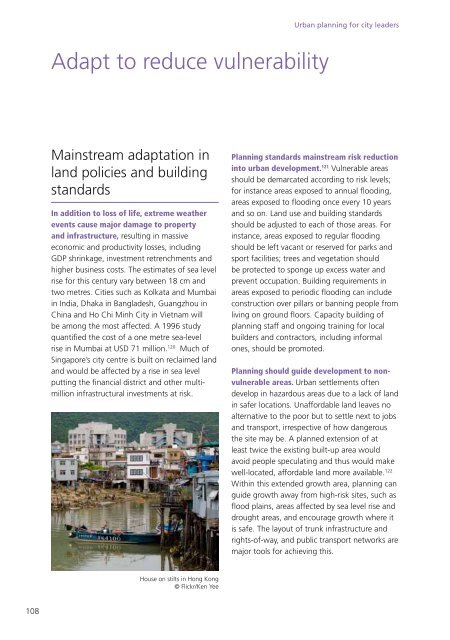Urban Planning for City Leaders - Cities Alliance
Urban Planning for City Leaders - Cities Alliance
Urban Planning for City Leaders - Cities Alliance
Create successful ePaper yourself
Turn your PDF publications into a flip-book with our unique Google optimized e-Paper software.
<strong>Urban</strong> planning <strong>for</strong> city leadersAdapt to reduce vulnerabilityMainstream adaptation inland policies and buildingstandardsIn addition to loss of life, extreme weatherevents cause major damage to propertyand infrastructure, resulting in massiveeconomic and productivity losses, includingGDP shrinkage, investment retrenchments andhigher business costs. The estimates of sea levelrise <strong>for</strong> this century vary between 18 cm andtwo metres. <strong>Cities</strong> such as Kolkata and Mumbaiin India, Dhaka in Bangladesh, Guangzhou inChina and Ho Chi Minh <strong>City</strong> in Vietnam willbe among the most affected. A 1996 studyquantified the cost of a one metre sea-levelrise in Mumbai at USD 71 million. 120 Much ofSingapore’s city centre is built on reclaimed landand would be affected by a rise in sea levelputting the financial district and other multimillioninfrastructural investments at risk.<strong>Planning</strong> standards mainstream risk reductioninto urban development. 121 Vulnerable areasshould be demarcated according to risk levels;<strong>for</strong> instance areas exposed to annual flooding,areas exposed to flooding once every 10 yearsand so on. Land use and building standardsshould be adjusted to each of those areas. Forinstance, areas exposed to regular floodingshould be left vacant or reserved <strong>for</strong> parks andsport facilities; trees and vegetation shouldbe protected to sponge up excess water andprevent occupation. Building requirements inareas exposed to periodic flooding can includeconstruction over pillars or banning people fromliving on ground floors. Capacity building ofplanning staff and ongoing training <strong>for</strong> localbuilders and contractors, including in<strong>for</strong>malones, should be promoted.<strong>Planning</strong> should guide development to nonvulnerableareas. <strong>Urban</strong> settlements oftendevelop in hazardous areas due to a lack of landin safer locations. Unaf<strong>for</strong>dable land leaves noalternative to the poor but to settle next to jobsand transport, irrespective of how dangerousthe site may be. A planned extension of atleast twice the existing built-up area wouldavoid people speculating and thus would makewell-located, af<strong>for</strong>dable land more available. 122Within this extended growth area, planning canguide growth away from high-risk sites, such asflood plains, areas affected by sea level rise anddrought areas, and encourage growth where itis safe. The layout of trunk infrastructure andrights-of-way, and public transport networks aremajor tools <strong>for</strong> achieving this.House on stilts in Hong Kong© Flickr/Ken Yee108
















